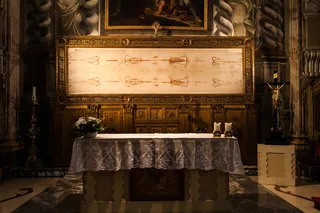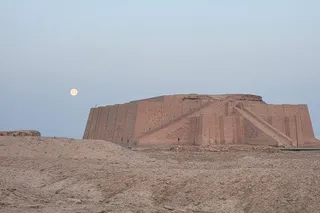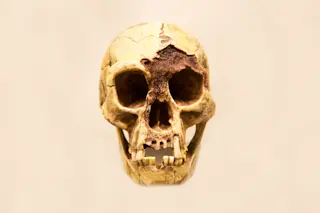The concept of sunken treasure has captivated the imagination of pirates, divers, and the general public for likely as long as ships have sunk to the bottom of the sea.
Part of the draw is that there are purportedly still a plethora of famous lost shipwrecks out there, such as the undiscovered Portuguese Flor do Mar, a treasure ship that was sunk in 1511 off the coast of Indonesia bearing dozens of chests of gold, precious gems and perfumes that might be worth billions today.
But other lost treasures and artifacts have been found below the surface of oceans, lakes or sinkholes, whether they were tossed into water as a kind of offering or went down with entire ships. Take a dive into five of these notable discoveries throughout history.
1. The Antikythera Mechanism

The Antikythera mechanism’s interlocking gears perplexed scientists for over a century. Historians now believe it was an elaborate conversation piece that tracked celestial movements and kept time. (Credit: National Archaeological Museum, Athens/Antikythera Mechanism Research Project/Kostas Xenikakis)
National Archaeological Museum, Athens/Antikythera Mechanism Research Project/Kostas Xenikakis
This ancient device was discovered in 1901 in the remains of a sunken merchant ship dating to the 1st century B.C. off the coast of Antikythera Islands in Greece. And researchers still haven't figured out exactly how the bronze instrument was used, which has been called everything from an ancient computer to the "dial of destiny," most recently in the latest installment of the Indiana Jones series.
Read More: Treasures Await Within Famous Ancient Shipwreck
Still, despite befuddling historians and scientists alike for over 120 years, experts have now surmised the ancient Greek device was likely meant for tracking the position of astronomical bodies like the moon and sun: Its inside is filled with tiny, complex gearworks that reveal a level of precision far ahead of its time.
The artifact was discovered with a number of other fabulous treasures, such as a well-preserved statue of a young man and a sculpture called the Philosopher’s Head. There may still be further treasures awaiting researchers in the shipwreck, as well.
2. The San José Treasure Galleon

Tea cups at the San José galleon wreck site. (© Colombian Ministry of Culture)
In 1708, a British attack sunk the San José galleon along the coast of Colombia near Cartagena. The ship may have carried gold, silver and emeralds now worth billions, but these are just estimates, as the vessel still sits under the water.
The Woods Hole Oceanographic Institution coordinated the operation that located the shipwreck in 2015 and has since released some photos of cannons, ceramics, tea cups and other objects. But since then, a legal fight has developed over who owns the precious items under the water.
Meanwhile, the Colombian government has plans to excavate the ship and bring the artifacts to the surface — a difficult operation due to the depth of the wreck, which lies anywhere between 700 and 2,300 feet below the surface .
3. The 1715 Treasure Fleet

Rare coins recovered from the 1715 fleet. (Credit: Augi Garcia/Wikimedia Commons)
Augi Garcia/Wikimedia Commons
Not even a decade after the San José galleon was sunk by a British attack, an entire treasure fleet sank off the coast of Florida — this time due to a hurricane. Nearly a dozen ships were sunk, in total, off the Atlantic Coast in 1715. The loot included gold and silver coins, and all kinds of jewelry. The location of each of the wrecks isn’t conclusive; some are still undiscovered, while others were salvaged by survivors or privateers.
Read More: Preserved Sunken Ship Found in Shipwreck Alley After 120 Years
In the 1960s, a company got a license from the state of Florida to salvage treasure from one of the wrecks and auction it off. Nonetheless, coins from the wreck still periodically wash up on the shores of central Florida.
4. Offerings at Lake Titicaca

(Credit: filrom/Getty Images)
filrom/Getty Images
One of the world’s highest lakes didn’t have a lot of large-scale shipwrecks. But ancient Andean people cast unique artifacts into the water of Lake Titicaca, on the border of Peru and Bolivia, for centuries before the Inca even arrived on the scene. In a 2019 study, researchers detailed gold medallions and stone carvings with religious iconography dredged from the bottom of the lake.
The scientists also found a lapis lazuli carved puma and a turquoise pendant near the Bolivian side of the lake’s Island of the Sun. There were also bones of baby llamas under the fresh lake water. Researchers believe these items were cast from boats by people from the Tiwanaku culture between 794 and 964 C.E. as offerings.
5. The Sacred Cenote

(Credit: Mardoz/Getty Images)
Mardoz/Getty Images
Framed by lush greenery and vegetation, the cenote at Chichen Itza is remarkable to look at. But the crystal-clear waters that fill the limestone sinkhole in the Yucatan Peninsula of Mexico hid a treasure trove of artifacts for centuries before researchers began to excavate.
Many of these objects were thrown into the water as a kind of ritual sacrifice or offering to the gods. Some of the most marvelous of these include an intricate gold mask, detailed gold plates, golden bells, and a tripod bowl with resin and jade beads, among other treasures.
Read More: 5 Important Artifacts From Ancient Maya Civilization
Many of these came from locations far away in Mesoamerica at the time of their origin. What's more, the waters of the cenote even preserved textiles, wood, and other objects that typically don't survive very well on dry land.
Article Sources
Our writers at Discovermagazine.com use peer-reviewed studies and high-quality sources for our articles, and our editors review for scientific accuracy and editorial standards. Review the sources used below for this article:
Discovery. What Happened to the Flor de la Mar Treasure Ship and Was it Ever Found?
Scientific Reports. A Model of the Cosmos in the ancient Greek Antikythera Mechanism
Independent. Sunken Spanish ship from 1708 could be ‘holy grail’ with $20bn of treasure
Woods Hole Oceanographic Institution. New Details on Discovery of San Jose Shipwreck
New York Times. A Treasure May Be Off the Coast of Colombia, but Who Can Claim It?
1715 Fleet Society. 1715 Treasure Fleet Exhibit
PNAS. Underwater ritual offerings in the Island of the Sun and the formation of the Tiwanaku state
The Met. Into the Centipede's Jaws: Sumptuous Offerings from the Sacred Cenote at Chichén Itzá
Harvard University. Artifacts from the Cenote of Sacrifice, Chichen Itza, Yucatan















